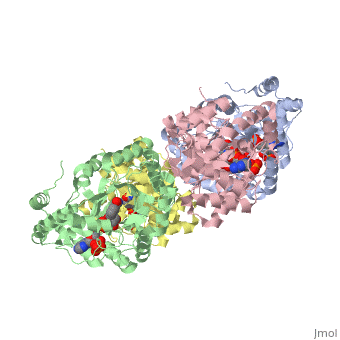Ion channels
From Proteopedia
(Difference between revisions)
| Line 8: | Line 8: | ||
Another property of ion channels is that they can be either driven by voltage or by concentration gradients, or they can be gated (by voltage, ligands, touch and other sensory signal).<br /> | Another property of ion channels is that they can be either driven by voltage or by concentration gradients, or they can be gated (by voltage, ligands, touch and other sensory signal).<br /> | ||
'''Potassium channels''' (KCh) are subdivided to voltage-gated KCh and calcium-dependent KCh. The latter are subdivided into high- (BK, LKCa), intermediate- and small-conductance KCh (human SK1, rat SK2, SKCa). <br /> | '''Potassium channels''' (KCh) are subdivided to voltage-gated KCh and calcium-dependent KCh. The latter are subdivided into high- (BK, LKCa), intermediate- and small-conductance KCh (human SK1, rat SK2, SKCa). <br /> | ||
| - | See: | + | See:<br /> |
[[Potassium Channel|Potassium channels]].<br /> | [[Potassium Channel|Potassium channels]].<br /> | ||
'''MthK''' is a calcium-dependent potassium channel from ''Methanobacterium thermoautrophicum''<ref>PMID:16735753</ref>.<br /> | '''MthK''' is a calcium-dependent potassium channel from ''Methanobacterium thermoautrophicum''<ref>PMID:16735753</ref>.<br /> | ||
'''MscL''' and '''MscS''' are large- and small-conductance mechanosensitive channels which protect bacteria from osmotic shock by allowing ions to flow across the cell membrane<ref>PMID:12046893</ref>.<br /> | '''MscL''' and '''MscS''' are large- and small-conductance mechanosensitive channels which protect bacteria from osmotic shock by allowing ions to flow across the cell membrane<ref>PMID:12046893</ref>.<br /> | ||
| - | See: | + | See:<br /> |
[[Mechanosensitive channels: opening and closing]].<br /> | [[Mechanosensitive channels: opening and closing]].<br /> | ||
'''Voltage-Dependent Calcium Channels''' (VDCC) allow calcium ions to enter the cell resulting in muscle contraction, neuron excitation or hormone release. VDCC are composed of several subunits and are named as a Cav gene product<ref>PMID:16096350</ref>. <br /> | '''Voltage-Dependent Calcium Channels''' (VDCC) allow calcium ions to enter the cell resulting in muscle contraction, neuron excitation or hormone release. VDCC are composed of several subunits and are named as a Cav gene product<ref>PMID:16096350</ref>. <br /> | ||
| Line 19: | Line 19: | ||
[[Voltage-gated calcium channel Cav1.1 complex]].<br /> | [[Voltage-gated calcium channel Cav1.1 complex]].<br /> | ||
There are also '''Voltage-Dependent Anion Channels''' (VDAC)<ref>PMID:16787253</ref>.<br /> | There are also '''Voltage-Dependent Anion Channels''' (VDAC)<ref>PMID:16787253</ref>.<br /> | ||
| - | '''Chloride ion channels''' (ClCh) are involved in maintaining pH, volume homeostasis and more. The anti-parasitic drug [[Ivermectin]] binds to glutamate-gated chloride channels. | + | '''Chloride ion channels''' (ClCh) are involved in maintaining pH, volume homeostasis and more. The anti-parasitic drug [[Ivermectin]] binds to glutamate-gated chloride channels.<br /> |
| - | See: | + | See:<br /> |
[[Chloride Ion Channel]]<br /> | [[Chloride Ion Channel]]<br /> | ||
[[User:Laura Fountain/Chloride Ion Channel]]<br /> | [[User:Laura Fountain/Chloride Ion Channel]]<br /> | ||
Revision as of 07:09, 20 January 2020
| |||||||||||
Weblinks
References
- ↑ Szewczyk A, Jarmuszkiewicz W, Kunz WS. Mitochondrial potassium channels. IUBMB Life. 2009 Feb;61(2):134-43. doi: 10.1002/iub.155. PMID:19165895 doi:http://dx.doi.org/10.1002/iub.155
- ↑ Venkatachalam K, Montell C. TRP channels. Annu Rev Biochem. 2007;76:387-417. PMID:17579562 doi:http://dx.doi.org/10.1146/annurev.biochem.75.103004.142819
- ↑ Zadek B, Nimigean CM. Calcium-dependent gating of MthK, a prokaryotic potassium channel. J Gen Physiol. 2006 Jun;127(6):673-85. PMID:16735753 doi:http://dx.doi.org/10.1085/jgp.200609534
- ↑ Kloda A, Martinac B. Mechanosensitive channels of bacteria and archaea share a common ancestral origin. Eur Biophys J. 2002 Mar;31(1):14-25. PMID:12046893
- ↑ Lacinova L. Voltage-dependent calcium channels. Gen Physiol Biophys. 2005 Jun;24 Suppl 1:1-78. PMID:16096350
- ↑ Shoshan-Barmatz V, Israelson A, Brdiczka D, Sheu SS. The voltage-dependent anion channel (VDAC): function in intracellular signalling, cell life and cell death. Curr Pharm Des. 2006;12(18):2249-70. PMID:16787253
- ↑ Keramidas A, Moorhouse AJ, Schofield PR, Barry PH. Ligand-gated ion channels: mechanisms underlying ion selectivity. Prog Biophys Mol Biol. 2004 Oct;86(2):161-204. PMID:15288758 doi:http://dx.doi.org/10.1016/j.pbiomolbio.2003.09.002
- ↑ Kaupp UB, Seifert R. Cyclic nucleotide-gated ion channels. Physiol Rev. 2002 Jul;82(3):769-824. PMID:12087135 doi:http://dx.doi.org/10.1152/physrev.00008.2002
- ↑ Holzer P. Acid-sensitive ion channels and receptors. Handb Exp Pharmacol. 2009;(194):283-332. doi: 10.1007/978-3-540-79090-7_9. PMID:19655111 doi:http://dx.doi.org/10.1007/978-3-540-79090-7_9
- ↑ Stroud RM, Miercke LJ, O'Connell J, Khademi S, Lee JK, Remis J, Harries W, Robles Y, Akhavan D. Glycerol facilitator GlpF and the associated aquaporin family of channels. Curr Opin Struct Biol. 2003 Aug;13(4):424-31. PMID:12948772
- ↑ Ruan Y, Liu N, Priori SG. Sodium channel mutations and arrhythmias. Nat Rev Cardiol. 2009 May;6(5):337-48. doi: 10.1038/nrcardio.2009.44. PMID:19377496 doi:http://dx.doi.org/10.1038/nrcardio.2009.44
- ↑ Meisler MH, Kearney JA. Sodium channel mutations in epilepsy and other neurological disorders. J Clin Invest. 2005 Aug;115(8):2010-7. PMID:16075041 doi:http://dx.doi.org/10.1172/JCI25466
- ↑ Watanabe H, Koopmann TT, Le Scouarnec S, Yang T, Ingram CR, Schott JJ, Demolombe S, Probst V, Anselme F, Escande D, Wiesfeld AC, Pfeufer A, Kaab S, Wichmann HE, Hasdemir C, Aizawa Y, Wilde AA, Roden DM, Bezzina CR. Sodium channel beta1 subunit mutations associated with Brugada syndrome and cardiac conduction disease in humans. J Clin Invest. 2008 Jun;118(6):2260-8. doi: 10.1172/JCI33891. PMID:18464934 doi:http://dx.doi.org/10.1172/JCI33891
- ↑ Dworakowska B, Dolowy K. Ion channels-related diseases. Acta Biochim Pol. 2000;47(3):685-703. PMID:11310970
Proteopedia Page Contributors and Editors (what is this?)
Michal Harel, Alexander Berchansky, Wayne Decatur, David Canner, Eric Martz, Ralf Stephan, Jaime Prilusky, Ilan Samish, Shelly Livne

